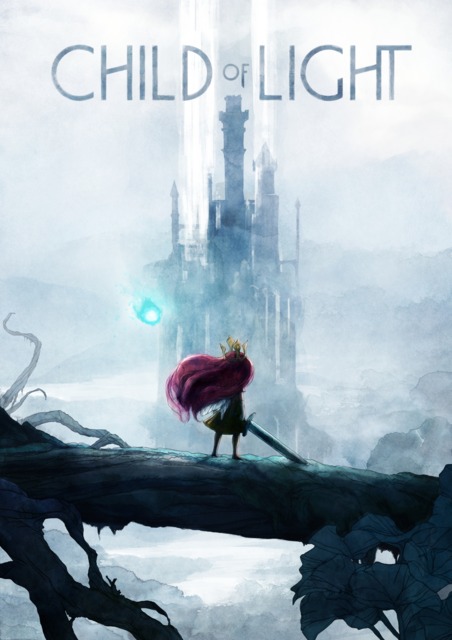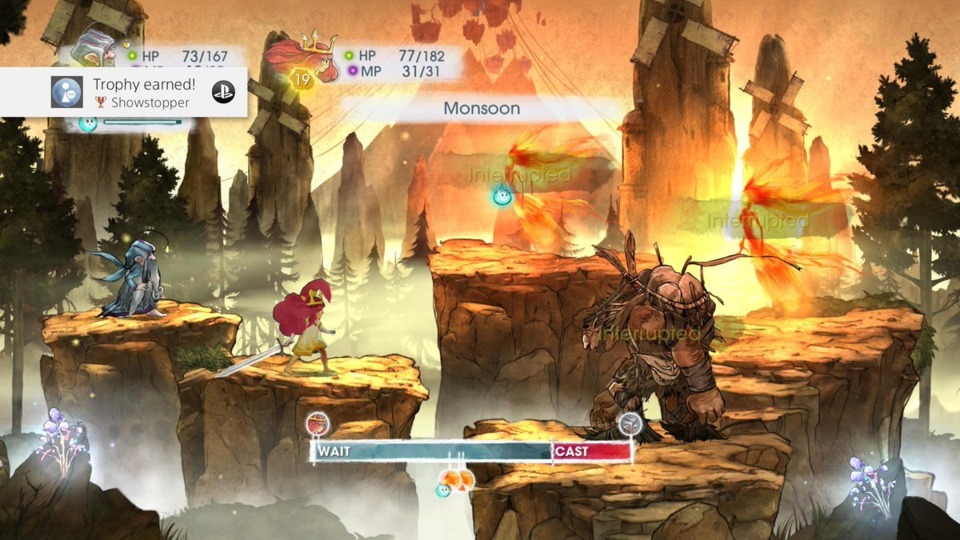
Once again stretching the definition of "Indie" here with another game crafted via Ubisoft's "UbiArt Framework" development tools, which was the source of a handful of smaller games from various Ubisoft studios taking a brief sojourn from building towers for assassins to leap off. I reviewed Valiant Hearts: The Great War a few Indie Game of the Week blogs ago, which was an Ubisoft Montpellier joint released in 2014, and Child of Light is its contemporaneous Ubisoft Montreal twin. Set in a fairytale world where everyone, including the narrator, is constantly talking in rhyme (there'll be more on that later, since I'm something of a hater), the core of the game is a stripped down JRPG homage in the Costume Quest/Zeboyd mold: rather than adopt the anime visuals or focus on the usual melodramatic everyday world-saving drama of a group of hyper-competent teens, they instead lifted the combat mechanics as the sole contribution from that sub-genre, and in Child of Light's particular case the turn shuffling and interruption gimmickry of the Atelier series, Grandia II or Radiant Historia. (Given the thematic similarities of young women making their way through light-hearted fantasy worlds, I might believe the former is the most likely influence.)
A brief primer on this system: Every character's icon moves along a turn gauge in real-time, and when they hit a critical zone towards the end of that gauge they are given a list of commands to execute. Depending on the command they choose, from using an item to attacking normally to casting a more elaborate spell or special ability, they then have to wait an additional amount of time for that action to occur. During this brief waiting period, they can be hit for damage and their turn is interrupted, effectively thwarting whatever they were hoping to do. Ideally, the player is able to judge their enemies' turns and hit them during this critical juncture to prevent them from causing too much damage. What can and often happens is the reverse, as the player mis-times how long it takes their characters to perform or underestimates how readily the enemy is able to beat them to the punch. Along with various buffs and debuffs that can speed up or slow down the pace at which a character's next turn approaches, the player also has a firefly companion that can distract enemies by hovering over them on the combat screen - the firefly is generally used to solve environmental puzzles or collect out-of-the-way items on the field, but has this small but important role in combat too (they can also provide healing to friendly characters they shine on, but it's usually only enough to keep them out of the danger zone). By using the firefly to slow down enemies just long enough for the player characters to hit them first, the player is able to interrupt their turns, hopefully indefinitely. It's a combat system of risks and time manipulation that's elegant and captivating enough to keep the game's battles fresh long into its runtime.

In addition to the main character, Princess Aurora (not that one), the player also recruits various companions as the game continues, from jesters to mouse archers to cowardly gnomes. While there are a lot of these companions - I'm up to six right now - there's only one other slot on the heroine's team during combat. This is largely for balance issues, as there can only be up to three enemies on the opposing side. To compensate, the game allows you to switch out characters on the fly, similar to Final Fantasy X, and this means it's easy to shift your party composition around to suit the current fight: a battle against an opponent with high physical defense that counters almost every physical attack means bringing in a magic-user for damage, while their partner might as well be the character that can buff their magic damage or turn speed. If someone gets injured, bring in the only character that can heal (though healing items are also plentiful - if finite, since there's no currency/mercantile systems). The freewheeling party system is enhanced a little by the fact that there's no equipment to speak of and all characters level up at a uniform rate regardless of their involvement in encounters, but there is a system of acquiring and crafting "oculi" - Diablo/Torchlight style precious stones that can be combined together for stronger versions and provide various passive boosts depending on where they are equipped, such as fire damage while attached to the weapon slot or fire resistance while attached to the armor slot - and there's only so many of those to go around, especially if you keep crafting stronger versions. What you instead tend to have, or at least this has been the case for me so far, two "preferred" party members which are your defaults and receive the best oculi while the rest come in for an advantageous spell or two before being switched out again.
As with many Zeboyd games, its simplicity is Child of Light's paradoxically strongest and weakest aspect. A lot of elements common to the genre have been removed here - the aforementioned missing equipment and mercantile systems, for instance - making the game feel threadbare at times. However, the combat can be surprisingly elaborate with the number of possibilities it provides between its myriad characters each of whom has separate skill trees to climb, and I can't say that the game hasn't been challenging, especially on "Expert" mode (the hardest of two difficulties, the other of which is called "Casual" and implied to be a walk in the park). At the point of the game I've reached, the difficulty has ratcheted up considerably, and the number of restorative items I've been stockpiling is rapidly dwindling. Bosses now regularly appear with physically-resistant/physical-counter adds, making my group attacks useless, and everything has so much health that it's a chore to take down even the boss's minions, let alone the boss itself. The bosses will also regularly resurrect their fallen henchmen and counter attempts to interrupt them with devastating debuffs, so that's fun. All the same, it's exciting that the game has finally begun to get serious, and I also appreciate that it gave me a significant grace period to learn the ropes of its turn-manipulation trickery and the unique utility of each of my characters before tossing me into the deep end.

With the sole exception of the irritating compulsory rhyming, which leads to a lot of script problems as characters desperately latch onto rhyming couplets which makes their statements come off as either trite or incongruous (and would it kill them to stick to a meter? Learn to poem, guys), I've been enjoying Child of Light a lot. Certainly more than Valiant Hearts, which had a more serious and novel premise but many more issues with the development engine as well as a cartoony aesthetic that doesn't mesh as well with the subject matter as effectively as the germane watercolor etherealness of Child of Light's storybook world. If it gets any more challenging, though, I'm not sure how much longer I can last. We're getting close to SMT levels here, which wasn't something I was expecting from a game that appears to be designed predominantly for a younger audience. Eh, it's not like kids aren't a whole lot smarter than I am.
Rating: 4 out of 5.
| < Back to 40: Samorost 3 | > Forward to 42: Stories Untold |
Log in to comment